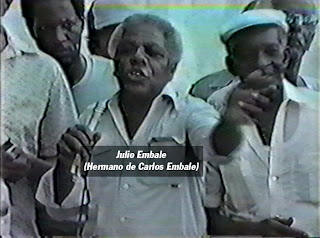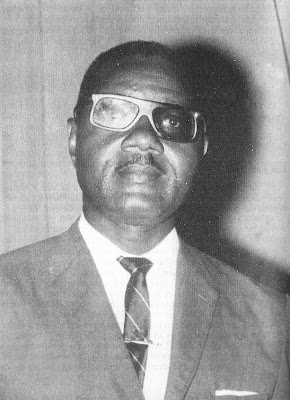One of our favorite rumberos, Miguel Chappottín Beltrán, turned 81 today, and we send him our best wishes for many more, y que sigue rumbeando.
María del Carmen Mestas, in her great book "Pasión de Rumbero" tells us:
Miguel was born [March 20, 1927] in a little solar at Picota y Merced, in Havana Vieja. He has a renowned name in music, since his father [Miguel Chappottín Batísta] was a famous sonero,
and regarding his uncle Félix [Chappottín, b. 31 March 1909; d. 1983], no one has yet been able to take the title from this great trumpeter, the most famous within son, because he created an original style.
Chappottín was with Las Estrellas Amalianas, together with the Izquierdo brothers — Los Pellos, as they were called — and the singers Julio Embale and Roberto Carillo.
Photo Credit: María del Cármen Mestas, "Pasión de Rumbero"
Later he was with Clave y Guaguancó, which he directed after the death of Mario Alán, and included Flor de Amor, Gustavo Martínez, Gloria Mora, Malanga and the dancer Mercedes Alfonso...
"It was a great idea that Argeliers León had, to recreate the most authentic music of the genre; the repertoire was of extremely old songs."
Video of Clave y Guaguancó from Cuban TV Special. Víctor Quesada "Tatín" on quinto;
Alfredo Gomes Paula "El Niño" on caja; Gustavo Martines "Cucharas" on guagua,
Gloria Mora and Rito Ramón Ordoñez Peraza "Mongo el Villano" in the coro,
and Miguel Chappottín as solista.
Alfredo Gomes Paula "El Niño" on caja; Gustavo Martines "Cucharas" on guagua,
Gloria Mora and Rito Ramón Ordoñez Peraza "Mongo el Villano" in the coro,
and Miguel Chappottín as solista.
"I went to the ports very young, where I gained a great family, I worked in various positions until I made it to overseer. There I had the pleasure of meeting Chori [Jacinto Scull], Chan [Juan Campos Cárdenas]...very happily we started the group Guaguancó Marítimo Portuario Zona 5. Our inspiration was [Calixto] Callava, as he would be later with Yoruba Andabo.
On the future of rumba, Miguel says:
"I'm afraid that this rhythm, so cuban, will be lost, and I say that with reason. I see that there are magnificent percussionists and dancers; in this this future is assured; now, where are the singers? I have been asking myself that for some time, and...I still haven't found an answer. We old folks are falling by the wayside, and it pains me to think that this music won't continue its development, because it is part of the heart of the people."
So come on people, go learn to sing a rumba today for Chappottín!
We conclude with an excerpt of a recent conversation we recorded between Chappottín and El Goyo, in Centro Habana. Chappottín reminisces about hearing Chano Pozo singing duets with Miguelito Valdés, and about his father, who was also a renowned Abakuá singer.
Remembering the old songs, he says they were often about the different barrios of Havana. Then he sings:
Dicen que en Jesús María
Hay una comparsa
Que tocan tambores
Cantamos, tocamos tambores
Para que la gente baile
¿Bueno y qué?
¿Bueno y qué?
¿Qué le hacemos a eso?
Nosotros los Amalianos señores
Sabemos divertirnos
Por eso los invitamos
Para que vengan a rumbear
A mi Amalia
Mi guaguancó, respeta todo aquellos que
guarden la forma y...
no dé lugar a mi canto
Pero porqué mi guaguancó
Es dulce sublime melodioso y...
¡Como pica!
Ya pueden decirlo así
Aqui se cierra el colegio
De los buenos cantadores...
Guaguancó óyelo bien!
Then El Goyo remembers a song he learned from Chappottín's father:
La noche está como el dia
dentro del cuarto Famba
todo se vuelve alegria
porque ha llegado el Morua
¡Akaman yusongo!
¡Akaman yusongo!
Bongo butame aranani kakua
mokuba afe afe
embori akua
Isue Eribo yaprofa ñongontemio,
sito awarariansa, Awana Bakoko Yamba,
Kanfioro Nankuko, Biabanga Efo
Embere mambere embere, efi efo
Embere mambere embere, efi efo
Marcha: Erume erume indio Abakua Awana Bakoko Yamba


